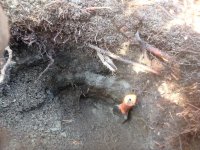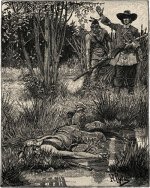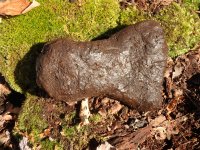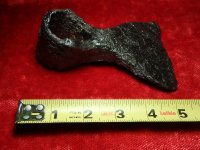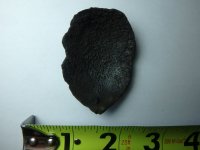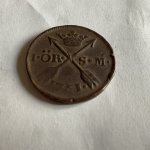Silver Tree Chaser
Bronze Member
The first find from a few weeks ago came soon enough – a fired musket ball recovered only a five minutes into my search. It was immediately followed by a much-deteriorated lug handle from a copper cauldron dating back to the 17th century. These were promising finds, but further signals proved elusive as I wandered around about the woods for the next two hours or so. I desperately hoped for further indication of an early site that had also seen action during King Philip’s War, a devastating conflict that raged throughout New England from 1675 to 1676. It was a war of annihilation between ever-encroaching English settlers and Native American tribes – the Wampanoags, The Nipmucs, and the Narragansetts, along with smaller sub-tribes. The war is named after the sachem of the Wampanoag, Metacomet, who started the uprising; he was given the Christian name of Philip by the English.
Mindful of my research and convinced that the initial finds were no fluke, I redoubled my efforts and eventually recovered a large fragment of thick brass. I then soon after came upon another promising signal at the base of a tree. I removed a large plug and some soil until my pinpointer indicated a signal further down into the hole. I was at first disappointed at the glimpse of a huge chunk of lead pinned under a tree root. I was certain that a rough fragment of lead would offer no solid connection to a 17th century dwelling, to say nothing of a dwelling where fierce fighting occurred. After removing some more dirt, I dislodged the lead out from underneath a tree root. It was certainly the biggest piece of lead I had ever found in my many years of detecting. Roughly oval in shape, it measured 4" x 2 & ½” x ¾” thick and would later weigh out at 1 pound, 3 ounces! I assumed it was a nondescript chunk of lead, most likely scrap, discarded by a farmer many years ago, but was it something else? Something extraordinary?
and convinced that the initial finds were no fluke, I redoubled my efforts and eventually recovered a large fragment of thick brass. I then soon after came upon another promising signal at the base of a tree. I removed a large plug and some soil until my pinpointer indicated a signal further down into the hole. I was at first disappointed at the glimpse of a huge chunk of lead pinned under a tree root. I was certain that a rough fragment of lead would offer no solid connection to a 17th century dwelling, to say nothing of a dwelling where fierce fighting occurred. After removing some more dirt, I dislodged the lead out from underneath a tree root. It was certainly the biggest piece of lead I had ever found in my many years of detecting. Roughly oval in shape, it measured 4" x 2 & ½” x ¾” thick and would later weigh out at 1 pound, 3 ounces! I assumed it was a nondescript chunk of lead, most likely scrap, discarded by a farmer many years ago, but was it something else? Something extraordinary? 
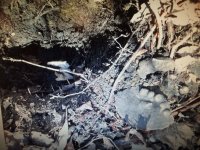
The lead had oxidized to a mix of colors from white to medium brown. As I wiped dirt from the lead chunk, I noticed several distinct lumps protruding from the otherwise featureless form. I was amazed to see that the lumps were actually musket balls fused to a lead ingot! A total of five musket balls were melted to the ingot, and from the same hole emerged a few more pieces of lead and a single loose musket ball. Further searching nearby uncovered several more musket balls, more scraps of lead, iron, and a piece of black colonial glass that I chanced upon while digging.
A total of five musket balls were melted to the ingot, and from the same hole emerged a few more pieces of lead and a single loose musket ball. Further searching nearby uncovered several more musket balls, more scraps of lead, iron, and a piece of black colonial glass that I chanced upon while digging.
What would explain to recovery of a lead ingot with fused musket balls? The answer is found in the history of King Philips War and a close examination of this unusual find.
The answer is found in the history of King Philips War and a close examination of this unusual find.
Here's a photos of the lead ingot with fused musket balls and related finds all dug from the same hole after being cleaned and preserved.
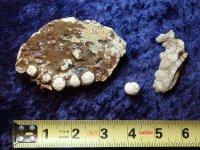
Close-up image of musket balls fused to the lead ingot.
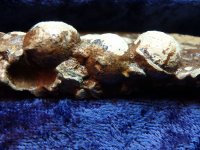
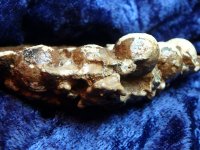
During King Philip's War, both the English and the Native American tribes cruelly resorted to fire in order to achieve victory against the enemy, and the toll was dreadful as English settlements and tribal villages alike, one after the other, went up in flames.
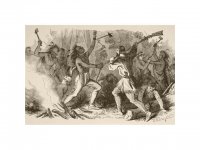
Battle of Turner's Falls
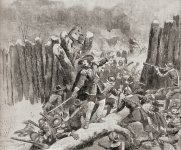
Great Swamp Fight
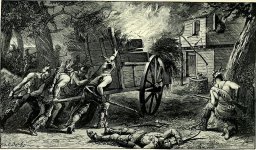
Brookfield, MA
The site that had produced this most unusual find had suffered the same fate. The dwelling was burned over 340 years. Most of it was consumed in flames and turned to ash, but some objects, including this object, the contents of a 17th century ball pouch, survived down through the centuries. Lead shot throughout the Colonial Period were cast by pouring molten lead into a bullet mold. The ingot was spare lead stock for manufacturing more shot as needed. Evidence for a ball pouch ID was observed in curious grooves on the backside of the ingot. The grooved surface seemed peculiar at first but was soon recognized as an imprint of material from the shot pouch itself; however, the imprint found on the ingot and another fragment of lead recovered nearby did not reflect the use sturdy leather expected in an English shot pouch.
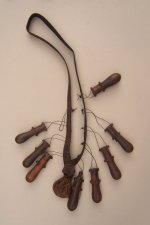
A Dutch ball pouch with bandolier – circa. 1600.
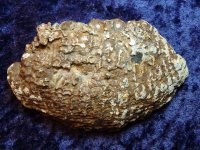
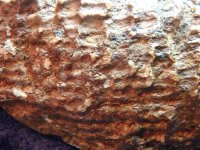
Peculiar grooved surface on back of lead ingot (complete image and close-up image). Notice the dark spot?
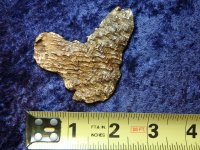
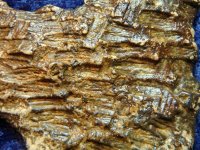
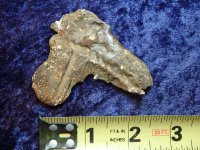
Crisscross pattern seen on another fragment of lead found nearby with close-up view and image of opposite side.
Amazingly, the impression from the material for the ball pouch showed clear use of a fiber weave. This shot pouch belonged to an Indian brave! The shot pouch was dropped during the deadly fighting, and the subsequent torching of the dwelling heated up the lead contents just enough to cause the balls to partially settle into the edge of the ingot, while the softened ingot itself absorbed a light impression of the hemp material from the bottom of the pouch. The fire eventually burned itself out, and the lead soon cooled forever preserving a moment in time from a brutal war fought over three centuries ago. The location of the dropped shot pouch, the intensity of the fire, and countless other factors led up to the recovery of this remarkable piece of history. If they intensity of the fire or the exact location of dropped ball pouch had varied even slightly, the inside contents would have likely been reduced to an unrecognizable clump of lead. I’m thankful that such a thankful scenario did not take place and more thankful for having recovered such a striking find.
The shot pouch was dropped during the deadly fighting, and the subsequent torching of the dwelling heated up the lead contents just enough to cause the balls to partially settle into the edge of the ingot, while the softened ingot itself absorbed a light impression of the hemp material from the bottom of the pouch. The fire eventually burned itself out, and the lead soon cooled forever preserving a moment in time from a brutal war fought over three centuries ago. The location of the dropped shot pouch, the intensity of the fire, and countless other factors led up to the recovery of this remarkable piece of history. If they intensity of the fire or the exact location of dropped ball pouch had varied even slightly, the inside contents would have likely been reduced to an unrecognizable clump of lead. I’m thankful that such a thankful scenario did not take place and more thankful for having recovered such a striking find.
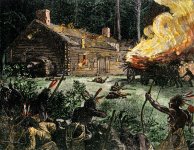
I’ve made several return visits to the site over the past few weeks, and have recovered a number of lead shot and a few other finds, but none so intriguing as the remains of a Native American ball pouch from the 17th century. Here some more images of recent finds upon recovery and after some cleaning and preservation. Some of the finds offer strong evidence of the dwelling being burned in the fighting.
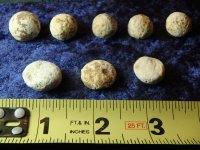
More shot of varying sizes have been recovered with most averaging near .45 caliber in size. Many of the lead balls show clear signs of impacting after being fired as seen in the bottom row.
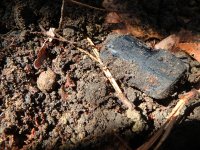
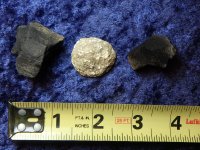
More evidence of the site being torched in the fighting. Charred pieces of wood were recovered while digging for musket balls and other targets. I've come upon several pieces of charred wood while digging.
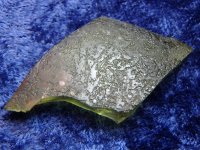
The piece of black colonial glass shows signs of being subjected to fire.
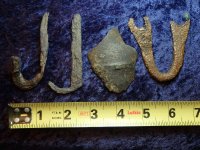
Other finds from the site include cookware - pots hooks, copper pot fragment, and a pot lug handle.
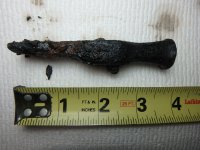
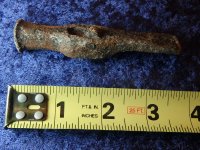
A hammerhead, a 345 year-old hammerhead! - photos taken during preservation and after being completed. I've opted for a coating of Renaissance Wax for now, but will followup with a hot wax treatment in the near future.
Finally, the last image - I apologize for such a long-thread. While taking photos for this thread, I took a closer look at backside of the ingot with the view of the fiber weave seen earlier in this thread; it has a dark spot. Here's a super-macro image of what I thought was some form of dark minerialization in the lead patina.
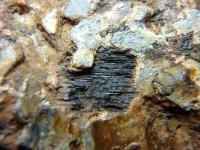
Actually it's a charred ember from the fiber weave of the ball pouch or from the burning dwelling. It settled into the molten lead and has remained preserved for nearly 3 & 1/2 centuries. It's a remarkable piece of history offering silent testimony of calamitous events during the early Colonial Period of America.
Be Safe and Good Hunting!
Mindful of my research


The lead had oxidized to a mix of colors from white to medium brown. As I wiped dirt from the lead chunk, I noticed several distinct lumps protruding from the otherwise featureless form. I was amazed to see that the lumps were actually musket balls fused to a lead ingot!
What would explain to recovery of a lead ingot with fused musket balls?
Here's a photos of the lead ingot with fused musket balls and related finds all dug from the same hole after being cleaned and preserved.

Close-up image of musket balls fused to the lead ingot.


During King Philip's War, both the English and the Native American tribes cruelly resorted to fire in order to achieve victory against the enemy, and the toll was dreadful as English settlements and tribal villages alike, one after the other, went up in flames.

Battle of Turner's Falls

Great Swamp Fight

Brookfield, MA
The site that had produced this most unusual find had suffered the same fate. The dwelling was burned over 340 years. Most of it was consumed in flames and turned to ash, but some objects, including this object, the contents of a 17th century ball pouch, survived down through the centuries. Lead shot throughout the Colonial Period were cast by pouring molten lead into a bullet mold. The ingot was spare lead stock for manufacturing more shot as needed. Evidence for a ball pouch ID was observed in curious grooves on the backside of the ingot. The grooved surface seemed peculiar at first but was soon recognized as an imprint of material from the shot pouch itself; however, the imprint found on the ingot and another fragment of lead recovered nearby did not reflect the use sturdy leather expected in an English shot pouch.

A Dutch ball pouch with bandolier – circa. 1600.


Peculiar grooved surface on back of lead ingot (complete image and close-up image). Notice the dark spot?



Crisscross pattern seen on another fragment of lead found nearby with close-up view and image of opposite side.
Amazingly, the impression from the material for the ball pouch showed clear use of a fiber weave. This shot pouch belonged to an Indian brave!
 The shot pouch was dropped during the deadly fighting, and the subsequent torching of the dwelling heated up the lead contents just enough to cause the balls to partially settle into the edge of the ingot, while the softened ingot itself absorbed a light impression of the hemp material from the bottom of the pouch. The fire eventually burned itself out, and the lead soon cooled forever preserving a moment in time from a brutal war fought over three centuries ago. The location of the dropped shot pouch, the intensity of the fire, and countless other factors led up to the recovery of this remarkable piece of history. If they intensity of the fire or the exact location of dropped ball pouch had varied even slightly, the inside contents would have likely been reduced to an unrecognizable clump of lead. I’m thankful that such a thankful scenario did not take place and more thankful for having recovered such a striking find.
The shot pouch was dropped during the deadly fighting, and the subsequent torching of the dwelling heated up the lead contents just enough to cause the balls to partially settle into the edge of the ingot, while the softened ingot itself absorbed a light impression of the hemp material from the bottom of the pouch. The fire eventually burned itself out, and the lead soon cooled forever preserving a moment in time from a brutal war fought over three centuries ago. The location of the dropped shot pouch, the intensity of the fire, and countless other factors led up to the recovery of this remarkable piece of history. If they intensity of the fire or the exact location of dropped ball pouch had varied even slightly, the inside contents would have likely been reduced to an unrecognizable clump of lead. I’m thankful that such a thankful scenario did not take place and more thankful for having recovered such a striking find. 
I’ve made several return visits to the site over the past few weeks, and have recovered a number of lead shot and a few other finds, but none so intriguing as the remains of a Native American ball pouch from the 17th century. Here some more images of recent finds upon recovery and after some cleaning and preservation. Some of the finds offer strong evidence of the dwelling being burned in the fighting.

More shot of varying sizes have been recovered with most averaging near .45 caliber in size. Many of the lead balls show clear signs of impacting after being fired as seen in the bottom row.


More evidence of the site being torched in the fighting. Charred pieces of wood were recovered while digging for musket balls and other targets. I've come upon several pieces of charred wood while digging.

The piece of black colonial glass shows signs of being subjected to fire.

Other finds from the site include cookware - pots hooks, copper pot fragment, and a pot lug handle.


A hammerhead, a 345 year-old hammerhead! - photos taken during preservation and after being completed. I've opted for a coating of Renaissance Wax for now, but will followup with a hot wax treatment in the near future.
Finally, the last image - I apologize for such a long-thread. While taking photos for this thread, I took a closer look at backside of the ingot with the view of the fiber weave seen earlier in this thread; it has a dark spot. Here's a super-macro image of what I thought was some form of dark minerialization in the lead patina.

Actually it's a charred ember from the fiber weave of the ball pouch or from the burning dwelling. It settled into the molten lead and has remained preserved for nearly 3 & 1/2 centuries. It's a remarkable piece of history offering silent testimony of calamitous events during the early Colonial Period of America.
Be Safe and Good Hunting!
Upvote
127




 This material should have all been fused together and reduced into one mass. The arrangement of the balls on top off and along the edge of the ingot also offers a clue. If the balls had been simply tossed into a melting pot, they would have bounced and scattered in the melting pot. Yet these musket balls are they all clustered together on one side of the ingot. The all collected together because of gravity - upon the ball pouch falling to the ground the musket balls settled at the lowest point along the lining of the pouch.
This material should have all been fused together and reduced into one mass. The arrangement of the balls on top off and along the edge of the ingot also offers a clue. If the balls had been simply tossed into a melting pot, they would have bounced and scattered in the melting pot. Yet these musket balls are they all clustered together on one side of the ingot. The all collected together because of gravity - upon the ball pouch falling to the ground the musket balls settled at the lowest point along the lining of the pouch. 